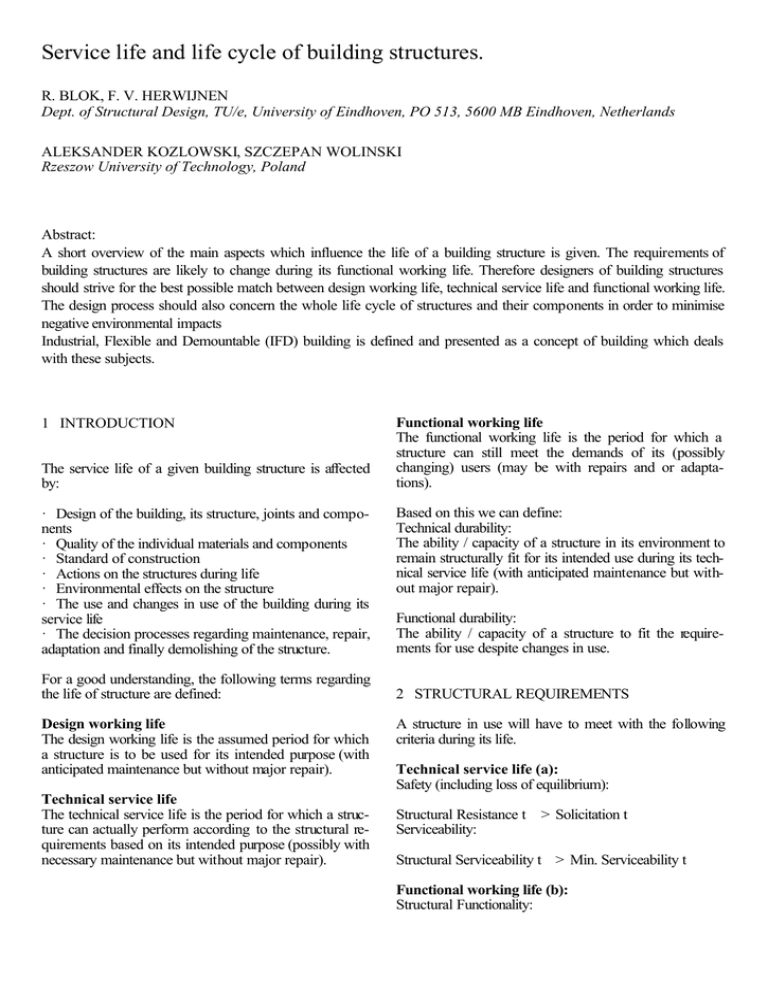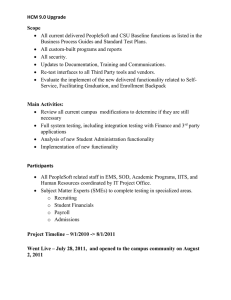Service life and life cycle of building structures.
advertisement

Service life and life cycle of building structures. R. BLOK, F. V. HERWIJNEN Dept. of Structural Design, TU/e, University of Eindhoven, PO 513, 5600 MB Eindhoven, Netherlands ALEKSANDER KOZLOWSKI, SZCZEPAN WOLINSKI Rzeszow University of Technology, Poland Abstract: A short overview of the main aspects which influence the life of a building structure is given. The requirements of building structures are likely to change during its functional working life. Therefore designers of building structures should strive for the best possible match between design working life, technical service life and functional working life. The design process should also concern the whole life cycle of structures and their components in order to minimise negative environmental impacts Industrial, Flexible and Demountable (IFD) building is defined and presented as a concept of building which deals with these subjects. 1 INTRODUCTION The service life of a given building structure is affected by: · Design of the building, its structure, joints and components · Quality of the individual materials and components · Standard of construction · Actions on the structures during life · Environmental effects on the structure · The use and changes in use of the building during its service life · The decision processes regarding maintenance, repair, adaptation and finally demolishing of the structure. For a good understanding, the following terms regarding the life of structure are defined: Design working life The design working life is the assumed period for which a structure is to be used for its intended purpose (with anticipated maintenance but without major repair). Technical service life The technical service life is the period for which a structure can actually perform according to the structural requirements based on its intended purpose (possibly with necessary maintenance but without major repair). Functional working life The functional working life is the period for which a structure can still meet the demands of its (possibly changing) users (may be with repairs and or adaptations). Based on this we can define: Technical durability: The ability / capacity of a structure in its environment to remain structurally fit for its intended use during its technical service life (with anticipated maintenance but without major repair). Functional durability: The ability / capacity of a structure to fit the requirements for use despite changes in use. 2 STRUCTURAL REQUIREMENTS A structure in use will have to meet with the following criteria during its life. Technical service life (a): Safety (including loss of equilibrium): Structural Resistance t > Solicitation t Serviceability: Structural Serviceability t > Min. Serviceability t Functional working life (b): Structural Functionality: Structural Functionality t Functionality t > Minimum User Defined Serviceability during the technical service life of a building structure. a. Technical service life: During its technical service life a building structure has to meet with minimum required levels of structural safety and, at the same time, has to meet with minimum levels of serviceability. Apart from structural safety the serviceability of the building and its structure play an important role in the life of a building structure. Both the level and the requirements regarding the serviceability can change in time. Deflections and cracking may increase in time, even to such an extend, that serviceability criteria are no longer met. Specification of appropriate serviceability limits regarding deflections, vibrations or cracking etc. may change as well (partly depending on how they are perceived by the users). Structural safety during the technical service life of a building structure The structural safety of a structure depends on the resistance and the solicitation of the structure. Both can be subject to seen or unforeseen changes in time. The resistance of a building structure is likely to change in time. Structural materials can be affected by deterioration, for instance depending on the moisture content of the materials. Sometimes the expected life of a structure can be predicted more or less accurate, for instance in the case of the estimation of fatigue life. Failure can be predicted in relation to the number of loading cycles. In the case of time dependent (strength) properties of materials, different models to predict the life of a structural element with a minimum level of safety are available. b. Functional working life The functional working life depends on the minimum user defined functionality on the one hand and the functionality of the structure on the other hand, combined with the ability of the structure to be adapted in such a way that the user criteria are met. With changing societies the demands of building occupants become more and more dynamic. An investigation carried out under companies in the Netherlands showed the following figures: 15 – 22 % of the companies want to move 10 – 15 % of the companies want to alter / rebuild (Source:NVB 1998) (Profit and Non-profit organisations in Holland move with an average of once every five years). If the functionality of a given structure meets the (new) users demands, no adaptations to the structure will be necessary. The functionality of a structure depends largely on aspects determined at the design stage. For instance: Fig. Deterioration of building components Sometimes however the life of a building structure is unforeseen short. The resistance, depending on the properties of the materials, can show a time depended behaviour different from our expectancy. For instance, in the case of unforeseen chloride induced corrosion of steel reinforcement in concrete, or ASR, alkali silica reactions in concrete. Also the solicitation of structures can be different from our expectancy: Rare or unforeseen actions on buildings can cause structures to fail. We sadly had to experience an example of this on the 11 th. sept 2001. Structural Integrity under exceptional loadings is an important subject dealt with in WG 2. · The location of the structure (and building) · Positions of bearing walls · Column free area of floors · Bearing capacity of the structural elements to accommodate functions with higher imposed loads · Height between floors to accommodate e.g. service ducts If the users functional demands are not met by the functional quality of the structure the functional working life depends on the capability of the structure to be adapted or else the functional working life of the structure will end. With regard to the adaptability of the structure we can distinguish the following influential aspects: · Bearing capacity of structural elements to accommodate adaptations elsewhere. · Characteristics of the existing structure with regards to possible strengthening or making new voids for ducts or stairs · The possibility to exchange structural elements (connections etc.) · Other building aspects which influence the possibilities for strengthening or exchange. · Possibility to disassemble and relocate the structure The relation between the functional working life and the technical service life can be shown graphical: Fig. Potential Functional Working Life versus Potential Technical Service Life. Structures for which the functional working life is smaller than the technical service life need to be taken out of the market. (Their functional life can be extended by finding new users with lower demands on structural functionality or by improving the level of functionality: adapting the structure). Structures for which the functional life ( in terms of years) is bigger than the technical service life should be repaired, upgraded or also dismantled because they don’t meet the safety or serviceability requirements. Because of the large expenses often involved in adapting building structures it can be advantageous to strive for a functional working life equal to the technical service life: the diagonal in the diagram above. An example of a project that strives for “the diagonal” is the XX-office Building in Delft, Netherlands. F. VAN HERWIJNEN discusses the design of the structure for this project in his paper “THE LOAD BEARING STRUCTURE OF THE XX-OFFICE BUILDING IN DELFT”. Several aspects are important in connection to the decision process to maintain, repair, adapt or demolish a building structure. Perhaps the most important aspect in achieving an optimal management strategy for new and existing buildings is economy. SZCZEPAN WOLINSKI discusses optimization of total expected life-cycle cost subject to minimum reliability requirements, optimization of the whole life building management, and also, evaluation of the remaining lifetime of existing structures in his paper ”ECONOMY AND LIFE-CYCLE ASSESSMENT” Building diagnostics In order to obtain the right information to support management decision processes, for instance whether and when maintenance and / or repair are needed, it becomes necessary to evaluate the performance of the structure. Several techniques to monitor, test and evaluate existing structures are available, and are still being improved and further developed. Building diagnostic play an important role in predicting the life of existing structures. The numbers of buildings built prior to the application of limit state design outnumber the ones that are built to latest views. Therefore building diagnostics play an important role in the decision process to maintain, repair, adapt or demolish the structure. The Life Cycle of structures Before, the Design working life, the Technical service life and Functional working life of structures have been discussed. However it is necessary to look beyond the life of existing and future building structures. The effects that building construction has on the environment plays an important role in our well-being. The effects of the extraction of raw materials, the production of materials with possible waste or toxic emissions but also the use of the products itself (with possible negative impacts) and the possible re-use should be considered. In short: the whole life cycle of the building structure. Sustainable Development implies that aspects concerning the environment, the vulnerability of the earth, exhaustible resources, and the quality of life are all to be taken into account. Sustainable Development is viewed as a major requirement for future technology. It is often referred to as consisting of three main points: 1. Integrated cycle management: the closing of the material cycle from raw material to waste material and emissions. 2. Reducing energy-consumption and the use of sustainable natural energy sources. 3. Quality improvement: Raising the quality of the products, the fabrication processes, minimising waste production and negative impacts on environment all aiming for a longer use of our available natural resources. Building waste Waste as a result of building construction makes a large contribution to the total production of waste, therefore is an important issue to be dealt with. Waste Categories 1999 2000* total total Re-use Incineration dumping discharging X 1000 Ton Total 57 340 58 750 45 270 7 240 5 085 1 155 8 385 8 645 3 860 3 645 1 140 - 18 000 19 000 17 950 200 850 - 1 815 1 820 1 765 45 10 - 20 320 20 225 16 490 1 270 1 310 1 155 8 820 9 060 5 205 2 080 1 775 - (1) Household garbage Building Agricultural Waste Industrial Waste other Fig. Building waste in Holland against total and other categories (RIVM) In building the word ‘prefabricated’ is often used as a The best ways to “deal with waste” is prevention, or resynonym for ‘industrial’. In this context prefabrication cycling with highest possible value. Less wanted is incinmeans to perform in the factory what was originally done eration or dumping. The prevention of building waste is on the building site, manufacture here is project specific. directly influenced by the possibilities of disassembling, An example of this is prefabricated concrete for colre-using, or recycling of structures, components and maumns, facade elements and the like. terials together with minimizing the use of materials and Besides there are industries that have of old only been energy. able to realise their production in the factory, because the material, the process and the necessary machines re“EFFICIENCY OF USING SEMI-RIGID JOINTS quire such. Examples are steel construction workshops, IN COMPOSITE FRAMES” is a topic discussed by but also industries that produce prestressed floor slabs. ALEKSANDER KOZLOWSKI with possible savings in the use of material as a result. Flexibility is the quality of a building or building component which allows adjustments according to the deDecisions made during the design of the building strucmands and wishes of the users. [1] ture and its elements play perhaps the most important Flexibility may relate to two stages: role in trying to minimise waste production and extending - the design stage: variability in the composition and the the life of building structures. use of material; - the user stage: flexibility to adjust the composition and From the important notion to strive for sustainable buildthe applied building components to the changing deing rose the concept of IFD, Industrial, Flexible and mands and/or wishes of the same or varying users while Demountable Building. in use. On the structural level, flexibility in the user stage may be translated into possible adaptability of the floors to higher working loads (the so called extreme live load) and the realisation of recesses for stairwells, lift shafts or 3 IFD BUILDING pipes and ducts. The placing of extra floors or mezzanines and the construction of extensions on ground level Industrialised and flexible building in itself is not new. must also be counted among these. However, the combination with de-mountable building is. The three elements of IFD building may be defined as Demountable building is the construction of a building follows: in such a way that a building component may be removed and possibly re-used or recycled, soiled as little By industrial building in this context we mean industrias possible by other materials, and without damaging the ally making of building products. surrounding building components.[1]. In recycling we do not use the complete product, but only its raw or pure material. Demountable building is also a means for the realisation of flexibility, because building components may be easily detached and replaced by other (industrial) building components. 4 CONCLUSIONS Many different aspects influence the service life and the life cycle of building structures. Both the requirements and the performance of building structures are likely to change during its functional working life. Therefore structural designers of building structures should consider besides the design working life also the technical service life and the functional working life as design parameters. The technical service life does not need to be much longer than the functional working life. Designers need to strive for the best possible match between design working life, technical service life and functional working life. The design should concern not only the service life but also the whole life cycle of structures and their components in order to minimise negative environmental impacts. An example of an approach in which the functional working life of structures can be increased is Industrial, Flexible and Demountable (IFD) building. References: 1. W.R. Millard and M.J. Robinson, The life of structures, proceedings of The life of structures, G.S.T. Armer, J.L.Clarke, F.K. Caras, Butterworths 1989 2. M. Hermans, Dynamics in policy and society. Changing requirements in plan development and building design (in Dutch), KPMG N.V. 1999 3. F. v. Herwijnen, Twintig duurt het langst, The structure of XX-office (in Dutch) Het Houtblad, March 1999 4. F. V. Herwijnen, Working life = Technical Service life, Masterclass Heerlen TU/e e.o.1999 5. CEN, Eurocode 1, Basis of design and actions on structures, part 1: Basis of design 6. P.J.G.M. de Bekker and A.J.N. Nijman, Environment and Building production (In Dutch), E.I.B. Economisch Instituut voor de bouwnijverheid, Amsterdam. 7. M.B. Kilmister Tall Buildings - Designing for economy, serviceability and long life, Collected papers Tall Buildings 2000 and Beyond, L. S. Beedle 1991 8. Tapio Leino, The service life design stategies, proceedings of the conference Eurosteel ’99, 1999 9. F. v. Herwijnen Development of a new adaptable and demountable structural system for utility buildings, TU/e researchpapers 2000, pp 55 – 67 10. Damen Consultants , Market potential of IFD building for Dutch Building industry (Dutch), Damen consultants Rotterdam, 1997

